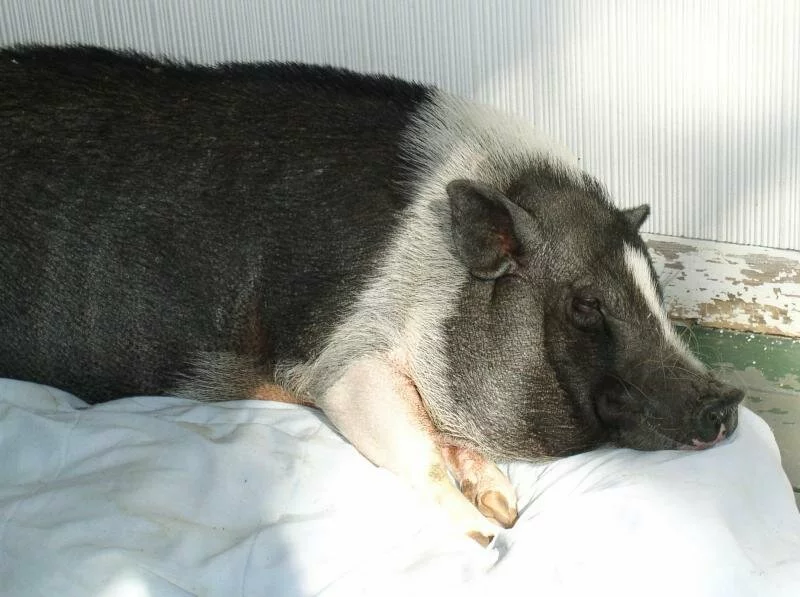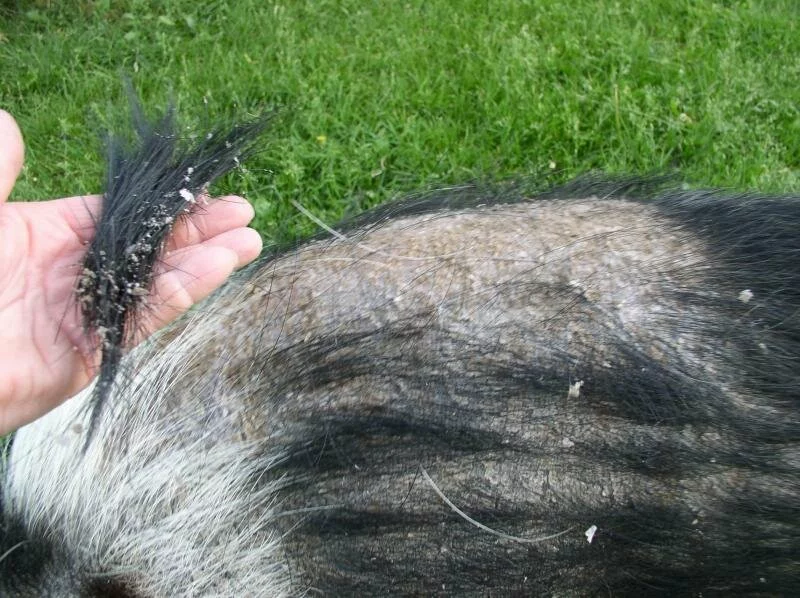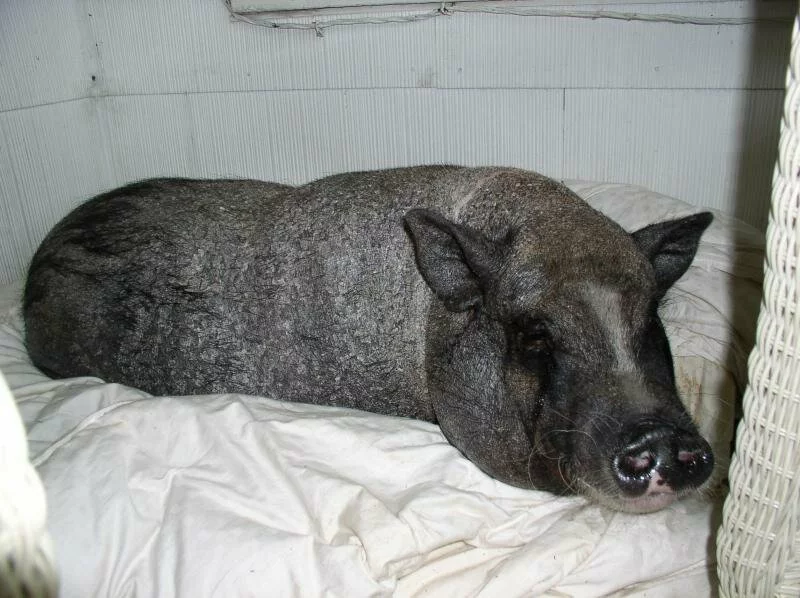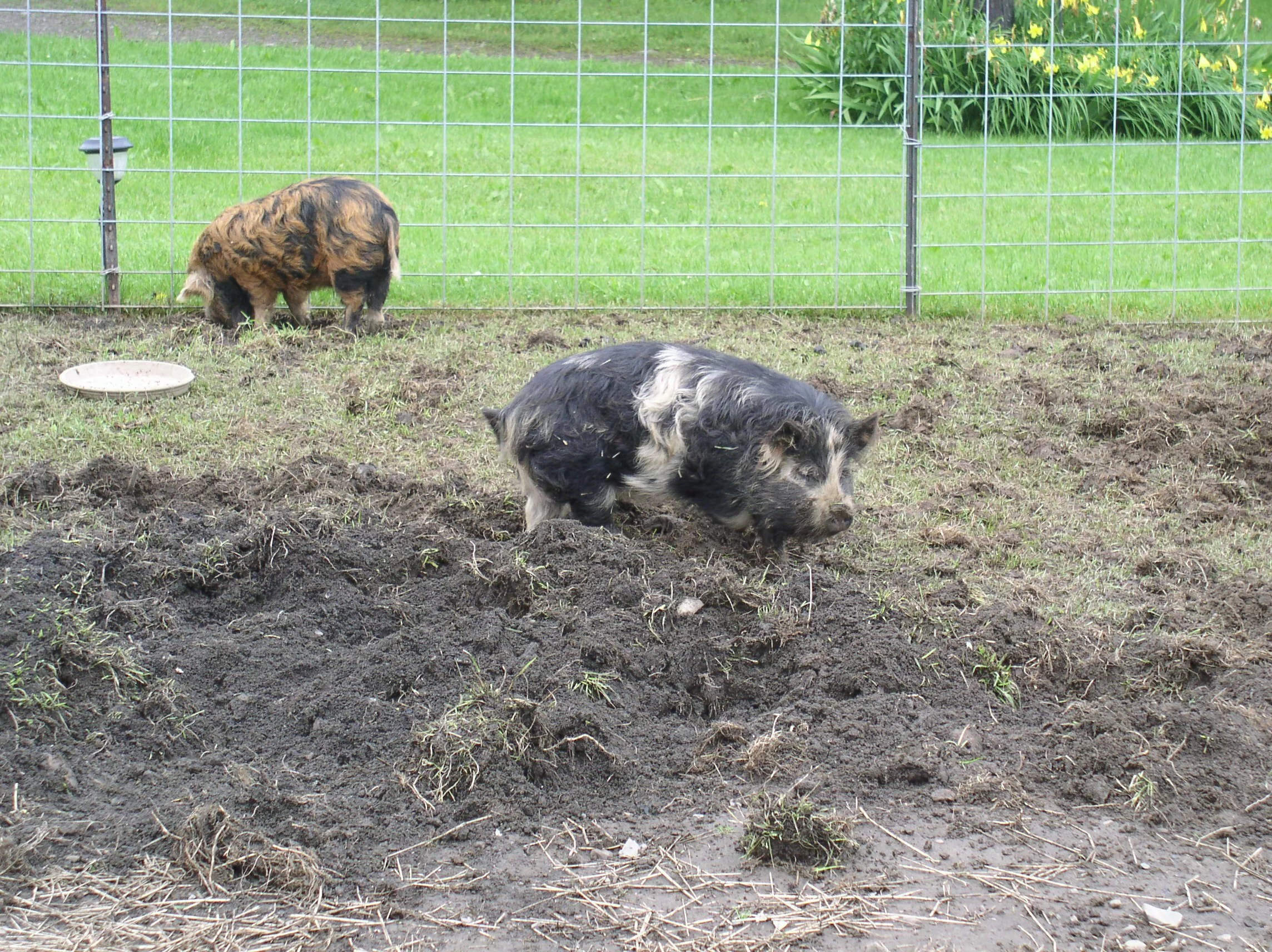CAMP SKIPPING PIG SANCTUARY
Snactuary
Dawn Camp @Camp Skipping Pig
1776 Torrey Hill Rd
Java Center, NY 14082
fax: n/a
- Home
- COMMOM MYTHS in no particular order
- So You Want a Pet Pig!
- About Us
- Beginnings
- YOUR PIG NEEDS...
- WHY DOES MY PIG...?
- HEALTH NOTES
- WHEN YOUR PIG IS SICK...
- Did They Tell You About...
-
FEEDING FOR HEALTH

- PIG WEIGHTS
- MOVE THE PIG (correct bad behavior)
- GILBERT WAS AN ANGRY PIG
- FOR SAFETY'S SAKE...
- DOGS-VS-PIGS
- Hannah Blue and Tooey "Teacups"
- Bugsy
- "Spot"
- Tea Cup and Micro Mini Pigs
- Teacup Myths...NAMING NAMES
- Why Are Sanctuaries Needed?
- SO YOU NO LONGER WANT YOUR PIG
- LINKS
- Swilbur's Story
- Our American Heritage pigs
- ANGELINA AHP
- SNORKLE
- Lia, Burn Study Pig
- Meet the Kunekunes
- Contact Us
- ART WORK
- WHO IS KENYA ?
- SUDAN and TSAVO
- RED WATTLE HOGS
- sNYGYL
- Jack & Jill
- JOY
- SNURDLE
- PETER
- GIZMO
- HARLEY
- SPAMLET
- SNICKERS
- 'LIL WILLIE
- PIGGLES
- RICHARD & REGGIE
- LUCY
- SNIPPET
- SASSY
- Rosie
- Photo Page
- A BIG THANK YOU!
- THE CATS
- Available Pigs
WHY DOES MY PIG...?
.....LOSE HER COAT ?
SNIPPET with full coat............................... going.......going...........................and GONE !
This is called "blowing the coat" and is a normal process for your potbellied pig. The bristles may come out by the handful. Within just a couple of days he may go from a fully "clothed" pig to totally bald. New bristles will come in and the new coat will continue to grow to its normal length. Most often we see this shedding process around June, but some pigs work on a different schedule. Some never have their coats fully return. It's not unusual for the older pigs to be partially bald or have strips or patches of bristles, and generally have an overall appearance of disrepair. Bradford never shed his thick mane (at one time a whopping 14" long!!!), but for years had sported bald sides. Though many breeders will tell you that pigs don't shed, they do, and often in a very spectacular manner! This is normal for the potbelly breed, but the Kunekunes typically don't shed like this, though they do shed out winter coats. We've found that they'll shed their "baby" coats more slowly and their color often changes with the shedding process. A chocolate colored pig may look black, at least for a while, and what appears to be a solid red pig may sport a white underbelly after shedding. A shaggy youngster may shed her coat and sport a smooth, sleek coat when the new one grows in. Our Kunekunes do shed every year, but in a much less notable way. When the Kunekunes sport a patchy coat, we've found it to be a result of mud-bathing and their finer, more hairlike bristles have broken off. Not to worry...blowing the coat is normal for your pig! However...if extensive hair loss is accompanied be severe itching, mange or lice should be suspected and your veterinarian consulted so treatment can begin immediately.
.....DIG UP MY LAWN ?
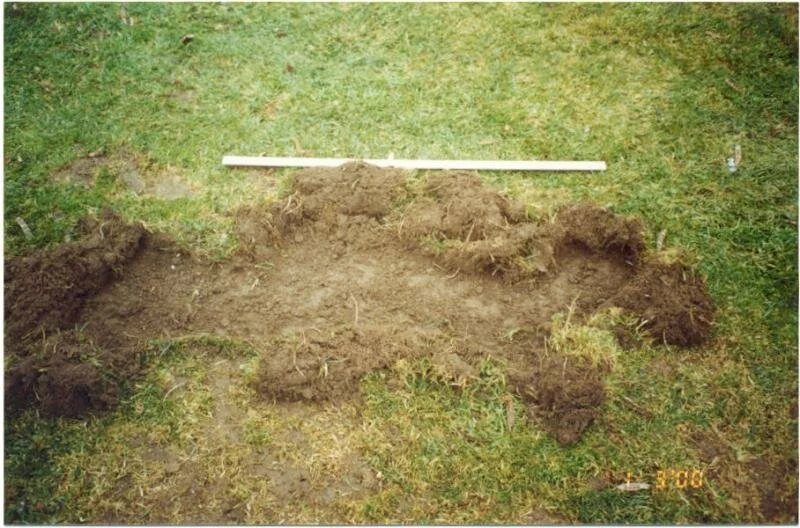
Rooting is normal behavior for a pig and should be expected and accepted. Your pig needs an area where she can dig in the dirt. She's looking for roots, grubs, a cool spot to rest, minerals, or for something to do. It's important for the pig's mental health to be able to root without being reprimanded. They don't understand why your lawn is such a precious thing and must have an area where digging is allowed. Nose rings are cruel and if you can't provide an outdoor area for your pig to enjoy, don't get a pig. Thanks to Ahurei for providing the example above. The white line is a yardstick. It took him only a few minutes to lay back the sod in the yard. Who said Kunekunes don't root !? Even our piglets enjoyed a good dig in the dirt their very first time outdoors, noses buried and butts in the air! Their little faces were COVERED in dirt! All pigs instinctively root.
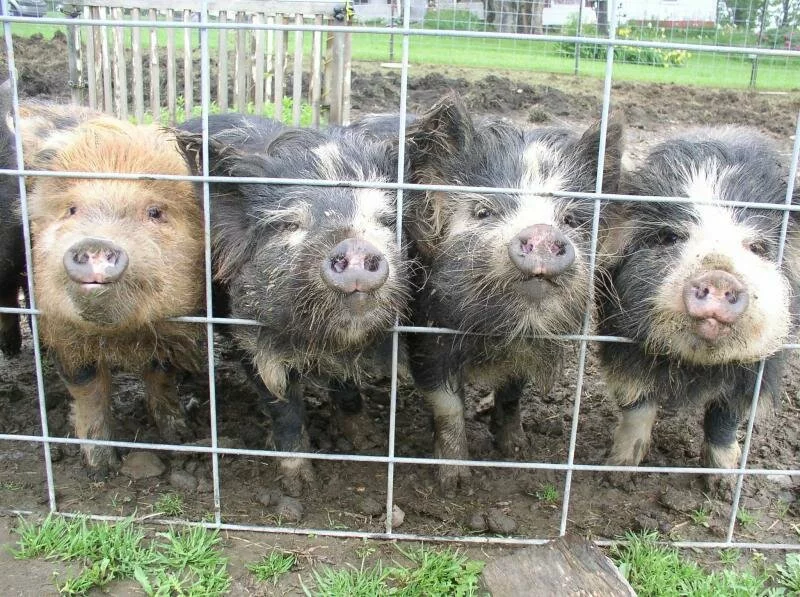
...SHRED PAPER AND FABRIC?
Shredding paper or fabric is as normal as rooting for your pig. They love to make a bed and whether they grab your old newspaper, laundry, or a sheet off the bed, it's bound to happen. Snippet used to run through the house with a newspaper before tearing it up. Brad regularly shredded his papers into a huge pile in the kitchen. Far better to offer old blankets, towels, newspapers or phone books for entertainment, than to find your designer draperies, couch cushion or down comforter ripped to ribbons and made into a pig bed. If your pig is cold he'll start looking for bedding material. Give him a good selection to call his own, but don't be surprised if he goes "shopping" for more. Oh...a word of warning...down comforters, after a pig "attack", look like a chicken exploded. I've found it best to offer these, when donated, to the barn pigs no matter how nice they look in the kitchen corner for the house pig. One little hole and a clump of escaped down combined with a blast of air from the forced air furnace...well, you get the idea. Feathers on the counter, feathers everywhere! Won't do THAT again!
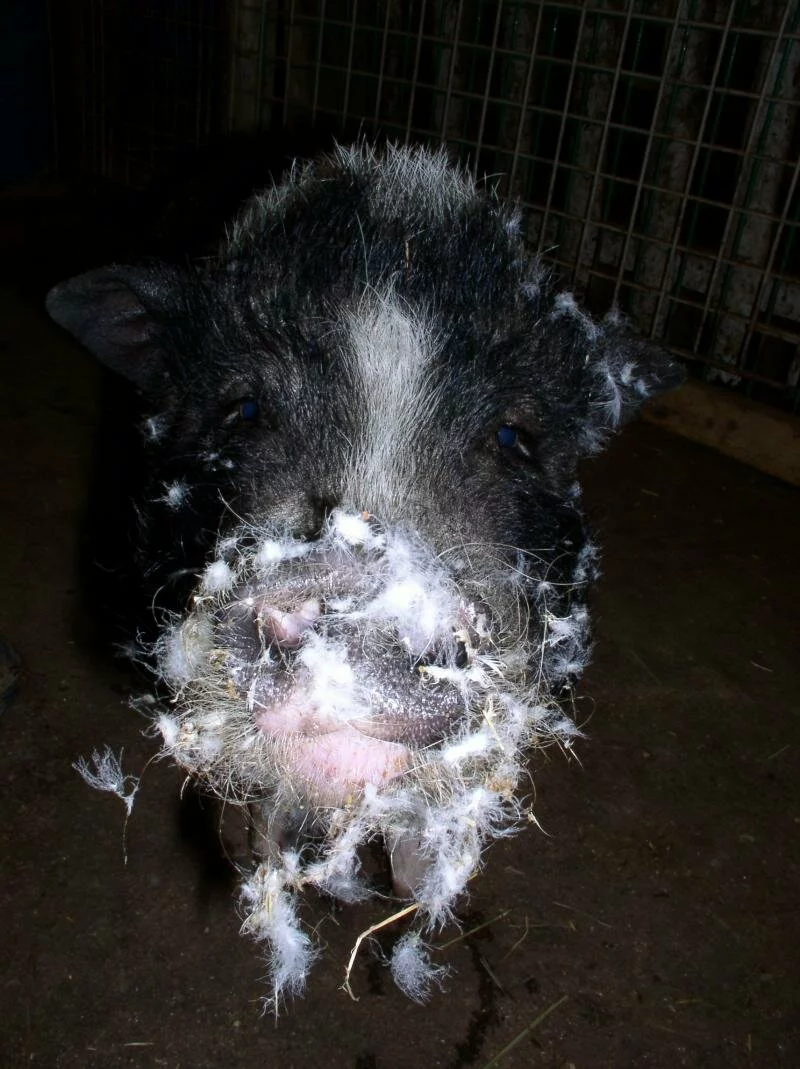
And another memory...a couple I knew had a pig who had his own decorating ideas. They special ordered a cammo patterned couch from Cabella's and proudly placed it in their living room. It wasn't inexpensive and I believe they waited some time for its arrival. Within a day or two Charles the pig apparently decided cammo wasn't his thing and, with his tusk, ripped it from one end to the other. I'm not sure what became of the couch, but Charles was moved to the barn.
...RAID THE REFRIGERATOR?
NEVER offer your pig treats directly from the refrigerator. He'll quickly learn to open the door and help himself. He may also attempt to MOVE your fridge. A large pig could possibly tip it over if he gets it in the right position. In addition to home decor, Charles the pig also had his own ideas about treat time and how to get them. Charles often raided the fridge by popping the door open with his nose, which fit perfectly at the gasket. His owners decided to prevent further raids by installing a counter high piece of plywood that slipped between the refrigerator and the counter, and came out flush with the front of the unit. The gasket was no longer exposed and there was nothing for Charles to hook his nose into to open the door. Within a few minutes Charles (a larger potbelly) decided that the door could still be opened if he put his front feet on the counter and reached over the plywood. It took his people longer to install the plywood than it took Charles to outsmart it. It's never a good idea to feed your pig from the fridge!
...LOVE A BELLY RUB ?
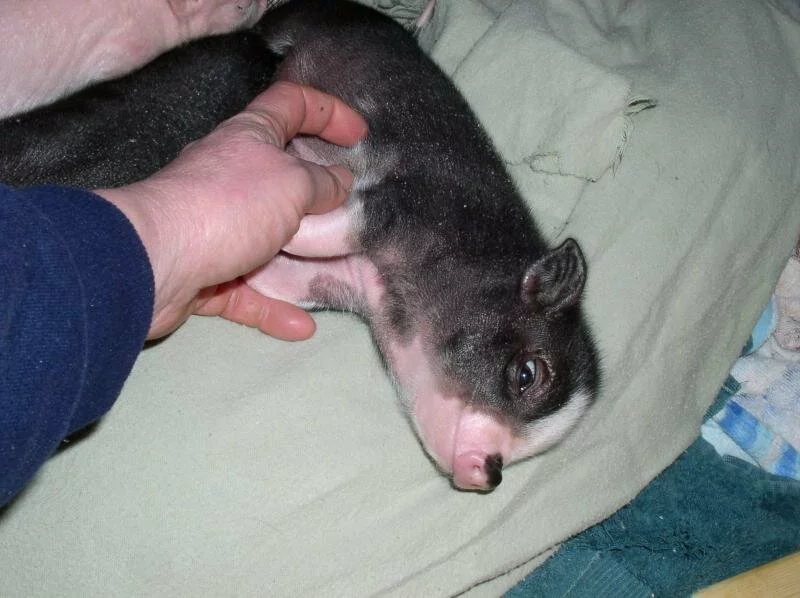
...TREMBLE? Trembling could be caused because the pig is chilled and simply covering it with a blanket and/or providing a (safely installed) heat lamp may resolve the issue. Trembling can also be caused by pain or illness and any pig that continues to tremble after being provided warmth needs to be evaluated by a vet. Start by taking its temperature and noting any variation from normal behavior. Provide this information to your vet. Look for signs of lameness, back pain, abdominal pain, bloating, respiratory trouble, pneumonia, etc. and work with your vet to resolve the problem. No pig should ever tremble.
...GRIND ITS TEETH?
Your pig may grind its teeth for several reasons. If young, it could be losing the baby teeth and the permanent teeth may be coming in. All of our babies have ground their teeth at this stage. Be sure teething is the cause, though, because grinding may also be a sign of pain or anxiety. If your pig is off its feed, even slightly, suspect pain or some sort of discomfort as the cause and investigate promptly. It could be a lameness or stomach issue, back pain, mouth pain, or an ear infection. It's important to know your pig and be tuned in to any changes in his attitude and behavior. Stress may also cause a pig to grind its teeth. Traveling, or a stressful situation, such as a new pet or visitors may also be the cause. Taking the time to get to know your pet will make it much easier to determine the cause of tooth grinding should your pig ever start. A pig in pain may tremble as well as grind its teeth.
...POOP IN THE POOL ?
One breeder offered the following suggestion for the poopy pool issue. Considering she had extensive knowledge regarding pigs and has owned many breeds over the years, I'll accept her explanation as being as good as any. Her theory regarding the potbellies is that they come from a forest environment. By eliminating in streams, the droppings are washed away, thus helping to conceal the pigs' whereabouts. The Kunekunes come from a place where daily rain is the norm. Their droppings are washed away every day, again helping to conceal their location. Pigs are instinctively very clean animals and would certainly be smart enough to use their own version of a flush toilet. Be sure to dump and clean your pig's pool frequently, especially if he uses it as a toilet. You can provide a smaller tip proof water tub for drinking water if your pig potties in the pool.
...WANT TO BITE ?
Pigs often become territorial, spoiled, and snippy and will use their tusks as weapons. Some pigs don't like children or strangers. Some may bite or snap out of fear. A pig in pain may bite. Spoiled pigs can behave like "brats" and may be snappy. Others may not like their beds disturbed. Some may snap if you push on their shoulder, which will be interpreted by the pig as a type of challenge to a fight. No matter the reason, a bite from a pig can be serious and should be treated immediately. A sharp tusk, even a smaller version as on the females, can rip to the bone. One person who was accidentally stabbed in an artery in his arm developed "blood poisoning" despite immediate hospital care. Males develop long tusks that may need to be trimmed to prevent an accidental puncture wound. We've trimmed arrivals' tusks that were as long as 6"! A two year old barrow's tusks may be two inches long, enough to cause a severe injury. A female's tusks don't grow as rapidly or as long, but still may reach at least an inch, again, long enough to cause an injury. If your pig is at all snappy, be sure to keep its tusks trimmed. Try to determine the root cause of the behavior and take steps to remedy the problem with training. We've found that even the grouchiest pigs benefit from LOTS of outdoor time. A bit less personal attention may be of help, too. A pig that receives too much attention can become very demanding and spoiled. If pain seems to be the cause the problem must be solved before his temperament will improve.We do NOT regularly trim tusks here. They are trimmed only ifgrowing improperly and causing a problem to the pig. We have never incurred a tusk injury, even with the "grumpy" pigs, but if you are at risk, talk o your vet about a trim. Sedation is not usually necessary, as it takes only moments to rim a tusk with giggly wire.
...ITCH A LOT ?
Any pig that spends an inordinate amount of time itching likely has MANGE or lice. It's easily and inexpensively treated with ivermectin (1cc/ 75 pounds). Give three doses at two week intervals. Severe cases may require longer and more extensive treatment, as a secondary infection may result. A skin scraping may not show the infestation, so it's easier to just treat for mange and save the lab fee. If the ivermectin doesn't resolve the itch, then you should look into other possibilities such as an allergy or insect bites. Young pigs with soft skin may get FLEA bites, but as a rule, fleas are not an issue with pigs due to their tough skin. I did see a three month old potbelly absolutely infested with fleas because he was kept locked in a bedroom with twenty (yes, 20) cats. The fleas could be seen "stampeding" thru the bristles. A new loving home and a good bath eliminated the problem. The water was tinted red from the flea droppings on his skin. If you begin to itch, it's possible that you've contracted mange from your pig. (Been there, done that!) See your doctor for treatment. One man believed he was allergic to his pig and wanted me to take it. I suggested treating for mange and seeing his doctor, and all was well in a short time. Pigs can also get LICE! Pig lice are very large and not hard to spot. Again, Ivermectin should solve the problem, but as with any parasite issue, the environment must also be thoroughly cleaned to prevent a re-infestation. Lice, in general are species specific, but mange can be spread to your other pets or yourself. In humans, the infestation is usually self limiting but a miserable experience, none the less!
Here is also a GREAT link to valuable information for anyone who wants or who already has a pet pig
Save it as a "Favorite" for quick reference! http://www.minipiginfo.com/
Copyright this business. All rights reserved.
Web Hosting by Yahoo!
Dawn Camp @Camp Skipping Pig
1776 Torrey Hill Rd
Java Center, NY 14082
fax: n/a
